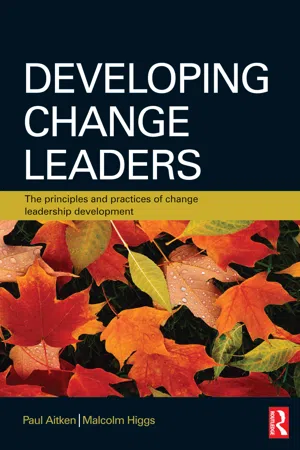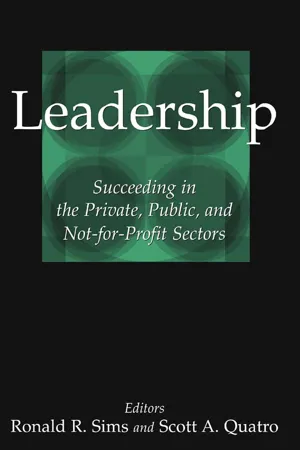Business
Organizational Leadership
Organizational leadership involves the ability to guide, motivate, and influence a group of individuals to achieve common goals within an organization. It encompasses the skills and strategies used by leaders to inspire and empower their teams, foster a positive work culture, and drive organizational success through effective decision-making and communication. Effective organizational leadership is essential for driving innovation, managing change, and achieving sustainable growth.
Written by Perlego with AI-assistance
Related key terms
Related key terms
1 of 4
Related key terms
1 of 3
7 Key excerpts on "Organizational Leadership"
- Pamela McCauley(Author)
- 2017(Publication Date)
- CRC Press(Publisher)
chapter three Leadership within an organizationTo be effective as a leader, it is important to understand how to add value in support of the vision and mission of an organization. Thus, an individual must gain some knowledge of Organizational Leadership within the environment, the specific organizational culture, and finally the organizational structure.Understanding Organizational LeadershipPart of being able to correctly lead within an organization depends on understanding the functioning of the particular organization. Organizations are far more dynamic than they once were; people no longer stay at the same company for their entire careers. It is essential to quickly adapt to and understand the needs of your organization in order for both you and it to grow. Thus, it is even more important that a clear perspective be gained early in one’s tenure at an organization. Generally, individual leaders are established throughout organizations to support the overall organizational objectives and goals. According to Zaccaro and Klimoski [1 ], the primary areas of Organizational Leadership that have some degree of consensus in the literature can be narrowed down to four principles. These broad principles include the following:1. Organizational Leadership Involves Processes and Proximal Outcomes (such as Worker Commitment) that Contribute to the Development and Achievement of Organizational PurposeLeadership positions are setup in the work place to enable organizational subunits to achieve the reasons for their existence within the larger system. The purpose of an Organizational Leadership is to set a direction for collective actions. The process of leadership is aimed at defining, identifying, establishing, or translating organizational directions for their followers and aiding or enabling the organizational processes that should result in the accomplishment of this function. Organizational purpose and direction is described in several ways, including through mission, vision, strategy, goals, plans, and tasks. The operation of leadership is inextricably tied to the constant growth and accomplishment of these organizational goals.- eBook - ePub
- Paul Aitken, Malcolm Higgs(Authors)
- 2010(Publication Date)
- Routledge(Publisher)
From this synopsis, it becomes apparent that in order to achieve the strategic goal, the leadership agenda will need to address the cultural, policy and practice dimensions as an early priority. In reality, cultural change tends to take quite some time (see below) and therefore, the priority areas for leadership to address will be associated with policies and practices. This dimension also tends to encompass structures. Therefore, in this example, a potential priority leadership focus may entail an initial intervention which would establish cross-functional teams to work on improving the effectiveness of product development processes. This example highlights the importance of considering the interaction between leadership and the organizational context in framing and prioritizing the change and development agenda for leaders.In the above discussion, the importance of culture as a significant aspect of the organizational context for leadership was highlighted. In the example, we considered how an understanding of the organizational context could help to frame the leadership agenda. However, the model in Figure 1.3 indicates a two-way dynamic relationship between the leader and their context. This invites consideration of how a leader can impact on the context and, in particular, on the culture of the organization.In order to explore the relationship between organizational culture, leadership and change, it is necessary to be clear as to what is meant by organizational culture. This is an area of considerable debate and a voluminous literature. Whilst it is beyond the scope of this paper to explore this vast literature, it is necessary to establish a frame for considering organizational culture. There are numerous definitions of culture that have been produced over the years. In searching for an appropriate definition, it would appear that there are many facets, with emphasis shifting according to the individual author. In addition, culture is impalpable, making definitions hard to relate to. For many, simply describing what culture means let alone managing it can be difficult. Hofstede (1991 ) describes culture as ‘… software of the mind – a collective programming of the mind that distinguishes the members of one group of people from another’. Schein (1985 ) defines culture as ‘… the deeper level of basic assumptions and beliefs that are shared by members of an organization, that operate unconsciously, and that define in a basic taken-for-granted fashion an organization’s view of itself and its environment’. A more long-standing definition by Hall (1959 - eBook - ePub
Leadership
Succeeding in the Private, Public, and Not-for-profit Sectors
- Ronald R. Sims, Scott A. Quatro(Authors)
- 2015(Publication Date)
- Routledge(Publisher)
There is a profound difference between management and leadership, and both are important. To manage means to bring about, to accomplish, to have charge of or responsibility for, to conduct. Leading is influencing, guiding in a direction, course, action, opinion. The distinction is crucial. … Leaders are people who do the right things and managers are people who do things right. Leaders are interested in direction, vision, goals, objectives, intention, purpose, and effectiveness—the right things. Managers are interested in efficiency, the how-to, the day-to-day, the short run of doing things right. (Bennis 1997, 6)Leaders today face organizations that are flatter, more networked, flexible, diverse, and continually influenced by the globalization forces at play in the world. With this new model come new challenges and organizational priorities that extend beyond profit management and include a broader definition of what a successful workplace means. Organizations today also face increased emphasis on employee well-being, environmental protection, equitable treatment for all workers, and concerns for socially responsible business practices (Lipman-Blumen 1996). In such a fluid and diverse environment, effective leadership is more vital than ever if organizations are not only going to survive, but thrive. Leaders no longer have an effective blueprint for what their organization should look like nor does the new organizational model automatically equate management with leadership. Instead, today’s organizations realize that effective leadership not only exists, but is needed at every level of the organization.Developing more effective leaders is not just good advice for creating a successful organization, it is a vital prerequisite. In the tumultuous, globalizing environment that organizations face today, effective leaders must move their organizations forward, unleashing the best within others even during difficult times. And many would argue that today’s world is increasingly difficult, as it is a “time marked by two contradictory forces, interdependence and diversity, pulling in opposite directions” (Lipman-Blumen 1996, 3). While the globalization of markets has led to increased reliance on networks and relationships around the globe, it has also amplified the variety that exists within these networks. “The leadership challenge at the very top of complex organizations appears sometimes to be almost overwhelming. Establishing and implementing sensible strategies for business is rarely easy. In many situations today the technological, competitive markets, and economic and political uncertainties make strategic decision making horrendously complicated … thousands of executives around the world are facing just these kinds of challenges today” (Kotter, 1998, 13). - eBook - ePub
Applied Organizational Communication
Theory and Practice in a Global Environment
- Thomas E. Harris, Mark D. Nelson(Authors)
- 2018(Publication Date)
- Routledge(Publisher)
For most of us, these two exercises raise as many questions as they answer. Leadership is a process whereby an individual influences a group of individuals to achieve a common goal. Practically every perspective provides part of the picture on leadership in organizations. Like democracy, goodness, or other terms we all use frequently, leadership is a concept best defined by examining its seven general characteristics.Leadership CharacteristicsSeven concepts – vision, willing followers, influence, emotional intelligence, information seeking, situational adaptability, and communication – appear in the majority of leadership examinations. We offer these not as a complete picture, but as the underpinnings of effective leadership.First, leaders forward avisionthat clarifies direction, provides meaning, and motivates followers.A strong determination to achieve a goal or realize a vision – a conviction, even a passion is important. This sense of direction provides meaning. More and more organizations and their people are in a crisis of meaning. Those who would aspire to leadership roles in this new environment must not underestimate the depth of this human need for meaning. Getting people to commit to common values and objectives within an organization is the foundation of corporate culture.Second, leaders havewilling followers. This places the relationship between leaders and followers as the pivotal issue. Leadership is interpersonal more than it is personal and is used to create the interacting ebb and flow between leader and follower. This relationship will be further developed when we examine emotional intelligence below. Leadership clearly depends on responsive followers in a process involving the direction and maintenance of collective activity. Leadership is more likely to occur in groups, but it is equally important in interpersonal contexts.A third major attribute isinfluence. - eBook - ePub
Leadership Explained
Leading Teams in the 21st Century
- Nicholas Harkiolakis(Author)
- 2016(Publication Date)
- Routledge(Publisher)
The way in which leaders act or need to act has been extensively studied, and there are literally thousands of books and research publications out there on the subject for anyone to read. This chapter does not aim to replace or enforce that wealth of knowledge, but rather to point out some of the elements that contribute to the application of leadership, especially through the prism of the framework we developed in the previous chapter. To recap, two of the elements discussed in the previous chapter that define the playground of leadership in organizations are the organizational structure and culture. The former provides an organization with a hierarchy or roles and authority, while the latter provides the social norms that guide the behaviour of individuals. Organizational culture is also seen here as a form of structure as it ‘restricts’ and guides behaviour (in a fuzzy and unspoken kind of way) just as organizational structure does. In addition to these two elements, organizations have established processes for their members to follow in order to convert raw material and energy (human and other) into products and services.An additional aim of this chapter is to show that leadership is not as easy as might be imagined. Hopefully, a reality check about the skills, knowledge, experience and commitment required to succeed in leadership will show, to anyone aspiring to be a leader, how difficult and circumstantial the role can (sometimes) be.6.1 Leading organizationsFigure 6.1 Organizational upgradeIn acting out their role (exercising their authority as widely known), leaders manipulate the elements that define organizations (Figure 6.1 ). By changing (upgrading might be a less threatening term) the organizational structure, culture and processes, leaders can steer the organization away from current and future threats towards a direction that ensures its survival and sustainable growth. In order for this to be successful, they need to be able to ‘see’ the future and successfully perform that ‘upgrade’.Considering the ability to perform the upgrade first, we need to keep in mind that a leader’s primary function is to lead others. In that sense, they affect physical and social change through others. We do have leaders who are also involved in the front line (like Alexander the Great or a modern executive making sales or writing a piece of computer code to build Google), but this is usually done to get a sense of the battle rather than critically influence its outcome. Alexander the Great killed a few of his enemy’s soldiers in battle, but it is unlikely that this influenced the outcome of his battles in a direct way. However, it did inspire his troops to trust and follow him, as they saw him risking his life like everyone else. They were willing to trust him because he never asked anyone to take risks he wouldn’t take or to do something that he wouldn’t do himself. - eBook - ePub
Controversies in Management
Issues, Debates, Answers
- Alan B Thomas(Author)
- 2005(Publication Date)
- Routledge(Publisher)
If leadership is an inherently ambiguous term, clear communication might be easier if it were simply dropped altogether. We do not, for example, talk about ‘teachership’ or ‘managership’ but about teachers and teaching and managers and managing. Similarly we could use ‘leading’ to refer to certain forms of behaviour, and ‘leaders’ to refer both to those who occupy positions requiring this behaviour and to those who exhibit this behaviour even though it is not a formal requirement of their position. In other words, leaders include those who are formally designated as such and ‘informal’ leaders who engage in leading even though they are under no formal obligation to do so. This usage points to the fact that while informal leaders are, by definition, engaged in leading, this cannot be safely assumed in the case of formally designated leaders. However, in practice it is difficult to avoid using the word ‘leadership’ despite its ambiguities, but these distinctions need to be kept in mind throughout our discussion.When taken as a way of behaving, leadership has often been associated with the process of influence. According to Bryman (1986), a widely used working definition of leadership is that it ‘involves a social influence process in which a person steers members of the group towards a goal’. As he notes, this definition has several drawbacks. In particular, the notion of a social influence process is extremely broad and includes certain kinds of actions which are not normally regarded as acts of leadership. The threat of physical force, for example, is one way of exerting influence, but it has often been thought that a distinguishing characteristic of leading is its orientation towards securing voluntary compliance on the part of followers rather than forced obedience. For the purposes of this discussion, however, this rather fragile distinction between voluntary and involuntary compliance is less important than the general idea that leading is centrally concerned with influence. Thus the question of the significance or otherwise of leaders in organizations can be posed in terms of the extent to which they are capable of influencing organizational outcomes.The image of leadership as an influence process exercised by a group leader over its members suggests that leaders exist at many levels within an organization. Because organizations may contain many groups, such as shopfloor work-groups, project groups, departments, committees and boards, the linking of the idea of leadership with groups means that organizations have many leaders. Indeed, if the group element of the definition is dropped it seems that any and possibly every member of an organization can be engaged in leading. Thus Katz and Kahn’s (1978) definition of leadership as ‘the exertion of influence on organizationally relevant matters by any member of the organization’ indicates just that. Similarly, Mintzberg (1973) includes leadership as one of his managerial roles and, as we have seen, these roles are held to characterize all forms of managerial work. But this approach to leadership has the disadvantage of being so broad as to define the concept of a leader almost out of existence. I therefore prefer to retain the association between leadership and the exercise of influence over groups. - eBook - ePub
- Gopal K. Kanji(Author)
- 2012(Publication Date)
- Routledge(Publisher)
3 Asymmetry vs mutuality: the process of systemic leadership relies on the principle of mutuality, on the existence of a level where every member has equal opportunity to exercise influence, enjoys equal regard, and feels able to express ideas and to use initiative. On the other hand, it is also clear that the process is asymmetric in that the weight of influence will be shifting and unequal as different people assume different roles with different responsibilities at different times.4 Discipline vs creativity: ideas are the lifeblood of generative organizations, but they cannot all be implemented. This has to be managed in a disciplined way which does not discourage or suppress enthusiasm and inventiveness.5 Creation vs destruction: developing new perspectives means shattering old paradigms and changing old processes and practices. This may well be painful in human terms. It produces anxiety and fear and creates tensions between the participants. Anxieties must be managed so that people feel safe enough to collaborate.Vision, change and transformational leadershipLeaders need to provide a focal point for the energies, hopes and aspirations of people in the organization. Moreover, they are expected to serve as role models whose behaviours, actions and personal energy demonstrate the desired behaviours expected throughout the organization (Nadler and Tushman 1990).Organization-wide change demands, therefore, a long-term strategic approach, incorporating both ‘hard’ (strategy structure, systems and technology) and ‘soft’ (vision, values, behaviours and attitudes) issues (Graetz 2000). Not surprisingly, the effective management of change is an emergent issue in modern leadership theories placing new challenges for leaders.The Transformational Approach describes how leaders can initiate, develop, and carry out significant changes in organizations. The Transformational Leader Model (introduced by Bass) is concerned with the process of how certain leaders are able to inspire followers to accomplish great things (Northouse 1997).The transformational leader seeks to influence and motivate his or her collaborators so that they are aligned with the leader’s vision. Bass and Avolio (1994, cited in Cardona 2000) specify that transformational leaders try to get their collaborators to emulate them (idealized influence); communicate visions of the future that are attractive for their collaborators (inspirational motivation); stimulate them to be creative, without criticizing their ideas (intellectual stimulation); and provide them with individualized opportunities for learning and development (individualized consideration). Therefore, transformational leaders need to act as strong role models and create a vision that gives meaning and clarifies the organization identity. To some extent, under this model, leaders become ‘social architects’ (Northouse 1997).
Index pages curate the most relevant extracts from our library of academic textbooks. They’ve been created using an in-house natural language model (NLM), each adding context and meaning to key research topics.
Explore more topic indexes
Explore more topic indexes
1 of 6
Explore more topic indexes
1 of 4






